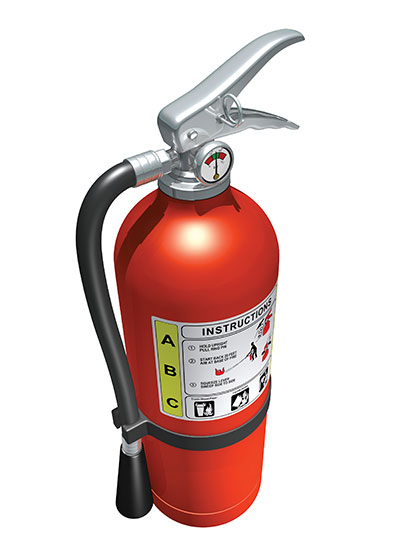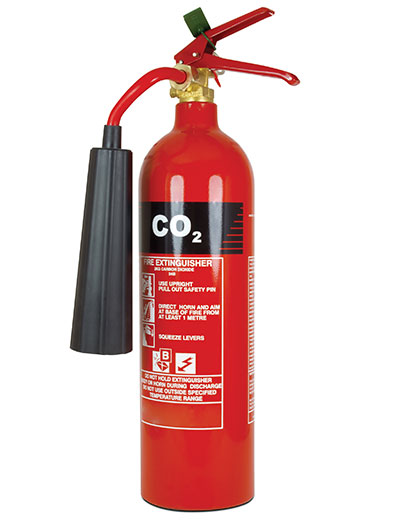
Equipment
Trainer’s Corner: December 2013
Before we get to the heart of this column, why not test your fire extinguisher knowledge?
November 22, 2013
By Ed Brouwer
Before we get to the heart of this column, why not test your fire extinguisher knowledge?
1. An extinguisher with an A rating is designed for use on:
- a. A fire involving energized electrical equipment
- b. A fire involving flammable liquids
- c. A fire involving combustible metals
- d. None of the above
2. An extinguisher with a D rating is designed for use on:
- a. A fire involving flammable liquids
- b. A fire involving combustible metals
- c. A fire involving energized electrical equipment
- d. A fire involving ordinary combustible materials
3. A fire involving flammable liquids is:
- a. Class A
- b. Class D
- c. Class B
- d. None of the above
4. A fire involving ordinary combustible materials is:
- a. Class A
- b. Class B
- c. Class C
- d. Class D
5. An extinguisher with a C rating is designed for use on:
- a. A fire involving flammable liquids
- b. A fire involving combustible metals
- c. A fire involving energizedelectrical equipment
- d. A fire involving ordinary combustible materials
6. An extinguisher with an ABC rating is designed for use on:
- a. Class A
- b. Class C
- c. Class B
- d. All of the above
7. An extinguisher with a K rating is designed for use on:
- a. A fire involving ordinary combustibles
- b. A fire involving energized electrical equipment
- c. A fire involving vegetable oils and fats
- d. A fire involving combustible metals
8. Which of the following is true regarding a flammable gas fire?
- a. Always extinguish the fire if a portable extinguisher is available
- b. Never extinguish the fire regardless of whether a portable extinguisher is available
- c. Extinguish the fire only if a spare extinguisher is available
- d. Extinguish the fire only if you are capable of promptly turning off the supply of gas
9. Which of the following extinguisher types does not have a gauge?
- a. A Halon extinguisher
- b. A carbon dioxide extinguisher
- c. A multipurpose dry chemical extinguisher
- d. None (all the extinguishers listed have gauges)
10. Where should you position yourself?
- a. Outside the room to avoid being trapped by the fire
- b. Next to a window so you can jump if your efforts to extinguish the fire are unsuccessful
- c. Six to eight feet from the fire, between the fire and your escape route
- d. As close to the fire as possible to ensure maximum efficiency of the extinguisher
Answers:
1. d, 2. b, 3. c, 4. a, 5. c, 6. d, 7. c, 8. d, 9. a, 10. c
It may be that one of the most overlooked tools of our trade is the fire extinguisher. Just about every piece of fire apparatus in Canada has an ABC fire extinguisher on board. In the proper hands, this little tool carries a big punch. I would recommend a yearly review of types of extinguishers including a hands-on practice with each firefighter demonstrating proper and safe use of a fire extinguisher. It may prove a little embarrassing if your firefighters do not know how to use a fire extinguisher.
 |
|
| The letters on the label of a fire extinguisher indicate the classes of fire that the extinguisher can put out. This extinguisher, for example, is suitable for ordinary combustibles such as wood, cloth, paper and rubber; flammable or combustible liquids; gases; grease and oil; and any fire that involves live electrical equipment. |
|
 |
|
| Carbon dioxide fire extinguishers are filled with non-flammable carbon dioxide gas under extreme pressure. They work by taking away the fire’s oxygen supply, and are frequently found in laboratories, mechanical rooms, kitchens, and flammable liquid storage areas. |
Basically a fire extinguisher is a portable device, carried or on wheels, and operated by hand, containing an extinguishing agent that can be expelled under pressure for the purpose of suppressing or extinguishing fire. Extinguishers are used to put out small, early stage fires. Extinguishers are not designed to fight large or spreading fires.
There are various types of fire extinguishers, each rated for different fire hazards. The different types of extinguishers are distinguished by their designated ratings, which indicate the type of fire hazard on which they are designed to be used. Extinguishers contain various extinguishing agents, such as carbon dioxide, water-based agents, dry chemicals, wet chemicals, dry powder and clean agent gas.
Fire extinguisher ratings are provided on the label of the fire extinguisher. The numbers assigned by Underwriters Laboratories indicate the relative effectiveness against each type of fire, regardless of the weight of the extinguisher or the chemical it uses. The higher the number, the greater the effectiveness. The letters indicate the classes of fire that the extinguisher can put out.
The number given on a Class A extinguisher represents the volume, in cubic metres, of combustible materials that an experienced individual may be able to extinguish. This rating ranges from 1A to 40A.
The number on Class B extinguishers represents the area in square metres – with no appreciable depth (appreciable depth is defined as a depth of liquid greater than six millimetres) – that may be extinguished by an experienced individual. This rating ranges between 1B and 320B.
The classification of the hazard (low, medium or high) will determine the numeral rating and the number of extinguishers required per floor area. A 2A:10-B:C fire extinguisher is recommended for a home, garage, car, boat or RV.
Class A – Ordinary combustibles such as wood, cloth, paper and rubber. The symbol for this class is a green triangle.
Class B – Flammable or combustible liquids, flammable gases, grease, oil and similar material. The Class B symbol is a red square.
Class C – A Class C fire is any fire that involves live electrical equipment. Once the electricity has been shut off, the fire becomes the class of whatever material is burning. The symbol for this class is a blue circle.
Class D – Certain combustible metals such as sodium, magnesium and potassium. You should not have to worry too much about this type of fire in your home. The symbol for this class is a yellow star.
Class K – Used on fires that involve vegetable oils, animal oils, or fats in cooking appliances. These extinguishers are generally found in commercial kitchens.
Here’s an easy way to remember these types of fires
- Class A leaves an ash
- Class B boils
- Class C has current
- Class D has dense material
- Class K for kitchen
Carbon dioxide extinguishers are filled with non-flammable carbon dioxide gas under extreme pressure. They work by taking away the oxygen element of the fire triangle; this can prove dangerous for the operator. Carbon dioxide extinguishers may be ineffective at extinguishing Class A fires because they may not be able to displace enough oxygen to successfully put the fire out. These types of extinguishers are frequently found in laboratories, mechanical rooms, kitchens, and flammable liquid storage areas. As of 2010, there are no refills for fixed Halon fire-extinguishing systems, except for critical uses. Alternative agents are available on the market and include inert gases, carbon dioxide, water mist systems, and clean agents. These agents are similar to Halon agents in that they are non-conductive
Water: Regular water extinguishers are the oldest type; the advantage of these extinguishers is that they do not leave any residue nor will they deprive the user of oxygen. There is an electrocution hazard if used on or around electrical devices.
Wet chemical: This type of fire extinguisher normally contains compounds such as potassium acetate and is intended to form a protective layer over burning liquids, depriving the fire of oxygen while lowering the liquid’s flash point. These are particularly useful on aircrafts and in kitchens, where fires should be smothered. Also, wet chemical extinguishers are highly effective for controlling grease fires. As with the water types of fire extinguishers, contact with live electrical devices can cause electrocution and should be avoided.
Foam: Foam extinguishers are widely used in industries that deal with combustible and flammable mixtures of fuel. The foam is intended to smother the fire and provide an airtight seal over the burning fuel. Additionally, foam extinguishers generally prevent flashback (the fire starting again) and can be used around electrical equipment. Because there are many chemicals within the foam, these extinguishers are rarely used around areas that store food.
AR-AFFF foam extinguishers contain an alcohol-resistant (AR) type of aqueous film forming foam (AFFF) that is specifically formulated for optimum use in a hand portable fire extinguisher.
Dry powder: Dry powder fire extinguishers are excellent at fighting all forms of fire and can be used in almost all environments. However, they do little to cool the heated material and there is a chance that the fire may reignite. Additionally, inhalation of the powder may cause respiratory distress. This extinguisher should be used only in a well-ventilated area.
The aforementioned extinguisher types are the more common types. The following are examples of single-purpose extinguishers:
Non-magnetic carbon dioxide extinguisher: For use in and around MRI rooms and suitable for use on energized electrical equipment.
Non-magnetic dry chemical extinguisher: For use outside and around MRI rooms and suitable for use on most common fires.
Hands-on training: A simple metal trash can or metal pail will serve nicely as a burn pan. We used a 45-gallon metal drum cut down to form a 20-centimetre-high pan. For fuel, we used one part gas to four parts diesel. We put in enough fuel to have it be 2.5 centimetres deep; we do not recommend filling the pan. If you have to add fuel, use diesel only and, even then, use extreme caution.
Once that is set up, get all firefighters to don their PPE, select the appropriate extinguisher, and safely extinguish the fire.
We live in an age of passwords, but here we use the word pass to help make sure you use a fire extinguisher properly. The acronym PASS stands for pull, aim, squeeze and sweep.
- Pull the pin that prevents the handle from being accidently squeezed.
- Aim the spray nozzle at the fire. Aim at the base of the fire, not directly into the flame.
- Squeeze the handle to spray the contents. If you release the handle, the discharge will stop.
- Sweep the nozzle from side to side while carefully moving toward the fire. Sweep back and forth from the base of the fire.
Cautions: Never turn your back on the fire, even if you think it’s out. Watch the fire area; if the fire re-ignites, repeat the process. Extinguishing agents must be used with care. They can damage equipment and materials and they can burn your skin or make breathing difficult. Using the wrong type of extinguisher for the wrong class of fire could be extremely dangerous and make the fire emergency worse. It is particularly dangerous to use water or a type A extinguisher on a grease or electrical fire.
Our department is considering providing fire extinguisher training for our community, by offering three 30-minute sessions on a Saturday morning. Each session would involve a hands-on experience.
Ed Brouwer is the chief instructor for Canwest Fire in Osoyoos, B.C., and Greenwood Fire and Rescue. The 21-year veteran of the fire service is also a fire warden with the B.C. Ministry of Forests, a Wildland Urban Interface fire suppression instructor/evaluator and a fire-service chaplain. Contact Ed at ebrouwer@canwestfire.org
Print this page